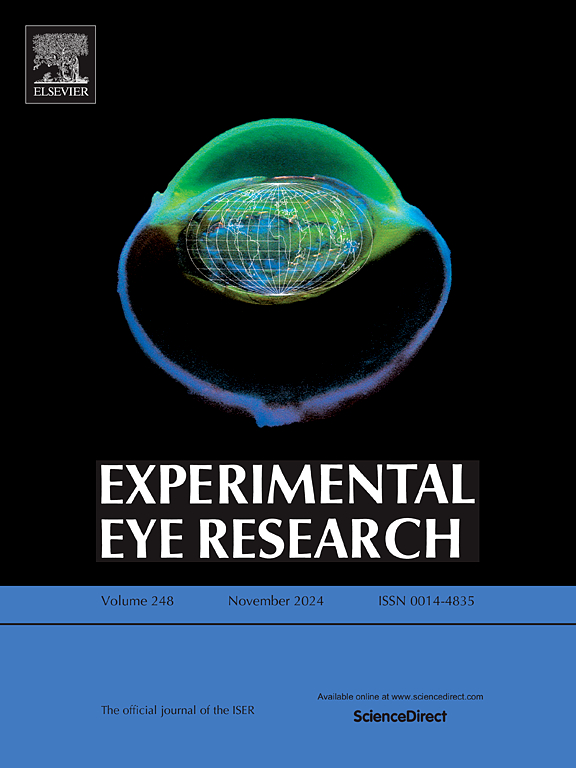L-carnitine partially restores adherens junction integrity and promotes wound healing in human corneal epithelial cells exposed to hyperosmolar stress
IF 3
2区 医学
Q1 OPHTHALMOLOGY
引用次数: 0
Abstract
Disruption of tear film homeostasis and increased osmolarity are key features of dry eye disease (DED), leading to inflammation, epithelial barrier dysfunction, and ocular surface damage. Adherens junctions, primarily composed of cadherins and catenins, are essential for maintaining epithelial integrity and modulating signaling pathways that regulate cell proliferation and migration. This study investigates the effects of hyperosmolarity on adherens junction proteins and wound healing, as well as the therapeutic potential of L-carnitine (LCAR) in mitigating these effects. To induce hyperosmolar stress, telomerase-immortalized human corneal epithelial cells (hTCEpi) were treated with 70, 90, and 120 mM NaCl, resulting in final osmolarities of approximately 450, 490, and 550 mOsM, respectively. LCAR supplementation (200 mM) was evaluated as a potential osmoprotective therapy. Hyperosmolarity caused a dose-dependent reduction in trans-epithelial resistance (TER), with a 30–69 % decline across treatment groups, along with significantly impaired cell migration. Adherens junction proteins (E-cadherin, β-catenin, and p120-catenin) were downregulated, while α-catenin was upregulated. Notably, L-carnitine treatment alleviated these effects, significantly restoring TER and adherens junction protein levels to near-normal. These findings demonstrate that hyperosmolarity impairs corneal epithelial barrier function and delays wound healing by altering adherens junction complex. Our results highlight the potential of L-carnitine as a therapeutic agent to restore epithelial barrier integrity and mitigate hyperosmolarity-induced damage in DED.
左旋肉碱部分恢复粘附连接完整性和促进伤口愈合暴露于高渗应激的人角膜上皮细胞
泪膜稳态破坏和渗透压升高是干眼病(DED)的主要特征,可导致炎症、上皮屏障功能障碍和眼表损伤。粘附连接主要由钙粘蛋白和连环蛋白组成,对于维持上皮完整性和调节调节细胞增殖和迁移的信号通路至关重要。本研究探讨了高渗透压对粘附物连接蛋白和伤口愈合的影响,以及左旋肉碱(LCAR)在缓解这些影响方面的治疗潜力。为了诱导高渗应激,端粒酶永活的人角膜上皮细胞(hTCEpi)分别用70、90和120 mM NaCl处理,最终渗透压分别约为450、490和550 mOsM。LCAR补充(200 mM)被评估为潜在的渗透保护疗法。高渗透压导致跨上皮耐药(TER)的剂量依赖性降低,在治疗组中下降30 - 69%,同时细胞迁移显著受损。粘附体连接蛋白(E-cadherin、β-catenin、p120-catenin)下调,α-catenin上调。值得注意的是,左旋肉碱治疗减轻了这些影响,显着恢复TER和粘附连接蛋白水平接近正常。这些发现表明,高渗透压通过改变粘附连接复合体损害角膜上皮屏障功能并延迟伤口愈合。我们的研究结果强调了左旋肉碱作为一种恢复上皮屏障完整性和减轻高渗透压引起的DED损伤的治疗剂的潜力。
本文章由计算机程序翻译,如有差异,请以英文原文为准。
求助全文
约1分钟内获得全文
求助全文
来源期刊

Experimental eye research
医学-眼科学
CiteScore
6.80
自引率
5.90%
发文量
323
审稿时长
66 days
期刊介绍:
The primary goal of Experimental Eye Research is to publish original research papers on all aspects of experimental biology of the eye and ocular tissues that seek to define the mechanisms of normal function and/or disease. Studies of ocular tissues that encompass the disciplines of cell biology, developmental biology, genetics, molecular biology, physiology, biochemistry, biophysics, immunology or microbiology are most welcomed. Manuscripts that are purely clinical or in a surgical area of ophthalmology are not appropriate for submission to Experimental Eye Research and if received will be returned without review.
 求助内容:
求助内容: 应助结果提醒方式:
应助结果提醒方式:


